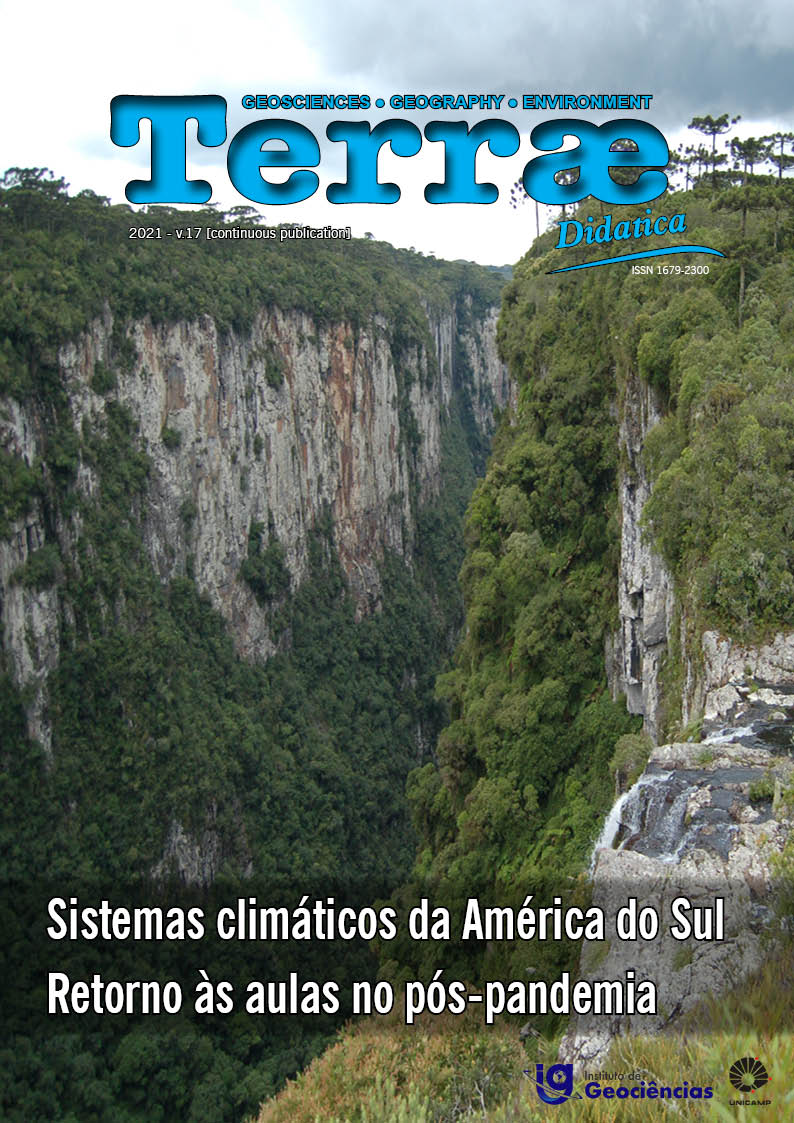Abstract
The teaching practice exposed here prioritizes creating opportunities in which the student theorizes and textualizes their meanings, exercising protagonism and citizenship. It seeks to promote the integration of so-called active methodologies, combining the best of the individual and group journey through a game in a digital environment, the Geoguessr, to discuss Geography and Mathematics skills and abilities together, valuing interdisciplinarity, one of the main premises the Pedagogical Model of the Integral Teaching Program and teaching in the 21st century. Geoguessr proved to be an efficient work tool due to its potential to assist in the construction of geographic thinking and expansion of territorial horizons, in addition, it also provided opportunities for mathematical methods and concepts, promoting interdisciplinarity in the development of skills and abilities involving location, number line and proportionality.
References
Almeida, R.D de. (1999). Moraes J.V. (2010). Ensinam Geografia para quem vive num outro mundo. In: V Encontro Nacional de Prática de Ensino em Geografia. In: Anais...Belo Horizonte: PUC/MG.
Almeida, M.E.B. (2010). Integração de currículo e tecnologias: a emergência de web currículo. Anais do XV Endipe, Encontro Nacional de Didática e Prática de Ensino. Belo Horizonte: UFMG.
Amabile, T.M., Hill, K.G., Hennessey, B.A., & Tighe, E.M. (1994). The work preference inventory: As sessing intrinsic and extrinsic motivation orienta tion. Journal of Personality and Social Psychology, 6(5), 950-967.
Bacich, L., Tanzi, Neto A., & Trevisan (2015). Ensino híbrido: personalização e tecnologia na educação. Porto Alegre: Penso.
Boot, W. et al. (2088). The Effects of Video Game Playing on Attention, Memory, and Executive Control. Acta Psychologica, 129 (3): 387-398.
Brasil. Parecer CNE/CEB nº 15/1998: diretrizes curriculares nacionais para o Ensino Médio. Brasília: CNE/ CEB, 1998.
Brasil. Ministério da Educação. Base nacional comum curricular: educação é a base. Brasília: MEC, 2017.
Breda, T.V. (2018). Jogos Geográficos na sala de aula. Curitiba: Appris, 120 p.
Bzuneck, J.A. (2004). A motivação do aluno: Aspectos introdutórios. In: Boruchovitch E. & Bzuneck J.A. (Eds.), Motivação do aluno: Contribuições da psicologia contemporânea. Petrópolis: Vozes.
Christensen, C., Horn, M., & Staker, H. (2015). Ensino Híbrido: uma Inovação Disruptiva?. Uma introdução à teoria dos híbridos. Porto Alegre: Penso, 320 p.
Csikszentmihalyi, M., & Nakamur, J. (1989). The dy namics of intrinsic motivation: A study of adoles cents. In: Ames, C., & Ames, R. (Eds.), Research on motivation in education: goals and cognitions. New York: Academic Press.
Diamond, A., Lee, K. (2011). Interventions Shown to Aid Executive Function Development in Children 4 to 12 Years Old. Science, 333 (6045): 959-964.
Dye, M., Bavelier, D. (2010). Differential Development of Visual Attention Skills in School-Age Children. Vision Research, 50 (4): 452-459.
Fitz, P.R. (2008). Cartografia Básica. São Paulo: Oficina de Textos, 144p.
Freire, P. (1996). Pedagogia da autonomia: saberes necessários à prática educativa. São Paulo: Paz e Terra, 144p.
Feng, J., Spence, I., Pratt, J. (2007). Playing an Action Video Game Reduces Gender Differences in Spatial Cognition. Psychological Science, 18, p. 850-855.
Green, J. (2000). Neuropsychological Evaluation of the Older Adult: a clinician’s guidebook. San Diego: Academic Press.
Gonçalves, H.J.L., Boni, B.R., Gomes, A.C.R. (2019). Currículo interdisciplinar no ensino integral: concepções de professores paulistas de Ciências da Natureza e Matemática. Revista Eletrônica de Educação, 13 (2): 645-658. doi: http://dx.doi.org/10.14244/198271992386
Honorato, M.A., & Mion, R.A. (2009). A importân cia da Problematização na Construção e na Aquisição do Conhecimento Científico pelo Sujeito. In: VII ENPEC, Encontro Nacional de Pesquisa em Educação e Ciência. Florianópolis. Disponívem em: http://posgrad.fae. ufmg.br/posgrad/viienpec/pdfs/titulos.html.
Li, R. et al. (2010). Reducing Backward Masking Through Action Game Training. Journal of Vision, 10 (14): 33-33.
Matlin, M. (2004). Psicologia Cognitiva. 5. ed. Rio de Janeiro: LTC.
Morán, J. (2015). Mudando a educação com metodologias ativas. In: [Coleção Mídias Contemporâneas. Convergências Midiáticas, Educação e Cidadania: aproximações jovens. Vol. II] Carlos Alberto de Souza e Ofelia Elisa Torres Morales (orgs.). PG: Foca Foto-PROEX/UEPG.
Neves, E.R.C., & Boruchovitch, E. (2007). Escala de avaliação da motivação para aprender de alunos do ensino fundamental (EMA). Revista Psicologia Reflexão e Crítica, 20(3), 406-413.
Ramos, D.K. (2013). Jogos cognitivos eletrônicos: contribuições à aprendizagem no contexto esco lar. Ciência Cogn., 18(1):19-32.
Ramos, D.K., & Segundo, F.R. (2018). Jogos Digitais na Escola: aprimorando a atenção e a flexibilidade cognitiva. Educ. Real., 43 (2): 531-550.
Ribeiro, M.W, Smaniotto, M., Galvão, W., Torres, M.A., Stefenon D.L. (2009). Os jogos pedagógicos no ensino de Geografia. Curitiba: Editora Positivo.
Santos, M. (2001). Por uma outra globalização. Rio de Janeiro: Record, 176 p.
Schuytema, P. (2011). Design de Games: uma abordagem prática. São Paulo: Cengage Learning.
Spreen, O., & Strauss, E. (1998). A Compendium of Neuropsychological Tests: administration, norms, and commentary. Oxford University Press.
Stefenon, D.L. (2016). Entre paisagens e distâncias: o jogo Geoguessr nas aulas de Geografia. Giramundo, 3 (6): 31/40.
Secretaria da Educação do Estado de São Paulo. (2012). Diretrizes do Programa de Ensino Integra. Governo do Estado de São Paulo. 57p. Disponível em: 342.pdf (educacao.sp.gov.br). Acesso em: 16 de set. 2021.
Siqueira, B. (2021). O ensino de Geografia Física e os jogos digitais: trabalhando suscetibilidade, vulnerabilidade e resiliência frente aos desastres naturais. Terræ Didatica, 15, 1-12. doi: http://10.20396/td.v15i0.8653224.
Xavier, A.C. (2011). Letramento digital: impactos das tecnologias na aprendizagem da Geração Y. Calidoscópio, 9(1), 3-14.

This work is licensed under a Creative Commons Attribution-NonCommercial 4.0 International License.
Copyright (c) 2021 Terrae Didatica


